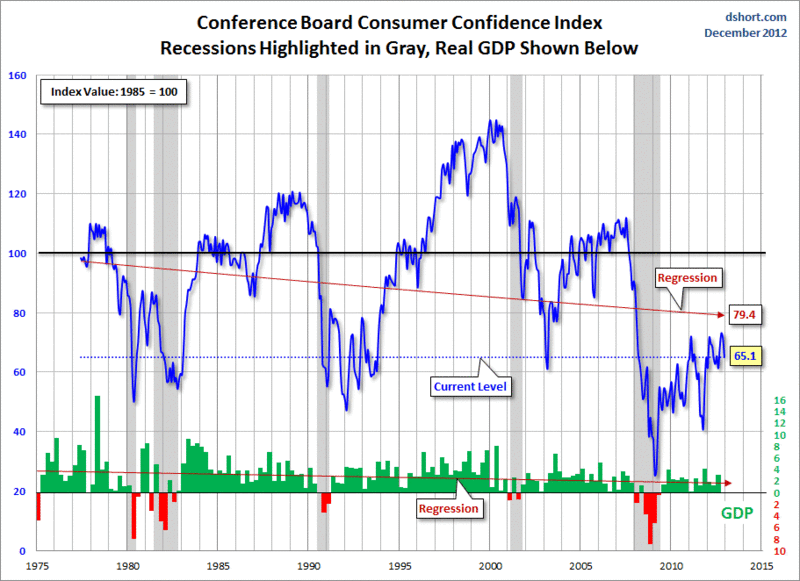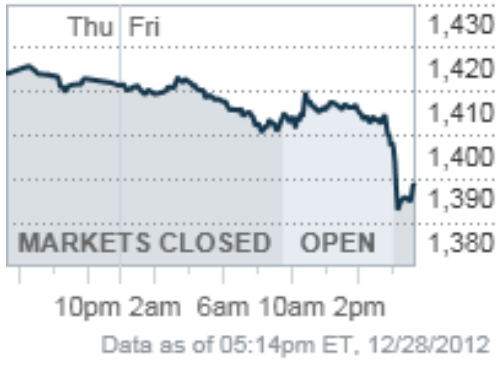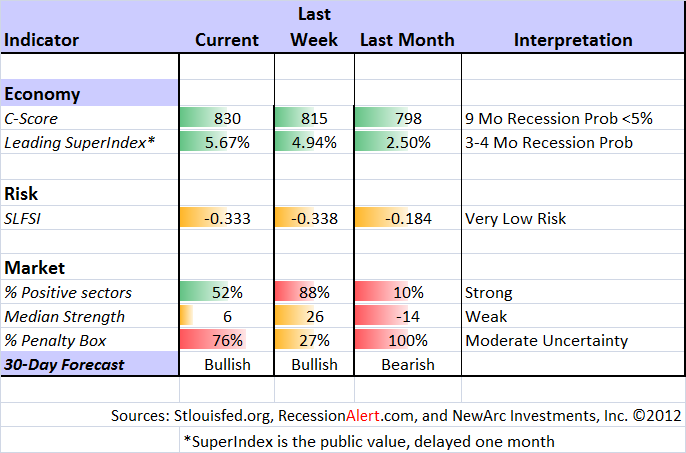For the first time in recent memory, the monthly payroll employment report will not be the big news.
The financial media are like one of those dedicated radio stations --- All Cliff, All the Time!
Last week I noted that I might skip this week's WTWA column, focusing on "Cliff notes." Meanwhile, I recommend that my readers follow the contributions of my colleagues in the Positioning for 2013 series. I certainly am.
I also highly recommend the "Gut Feeling" series from Scott Rothbort, my colleague at the Wall Street All Stars site. Scott does an excellent review of his 2012 predictions.
As to the coming week, there are a few things worth noting.
No one can say much with certainty before the legislative process plays out (although that is not stopping most from offering an opinion).
The outcome that I have long predicted as most likely -- a resolution of the main tax issues and deferral of spending cuts -- is still a live possibility.
I'll update the possibilities in the conclusion, but let us first hit some highlights from last week.
Background on "Weighing the Week Ahead"
There are many good lists of upcoming events. One source I especially like is the weekly post from the WSJ's Market Beat blog. There is a nice combination of data, speeches, and other events.
In contrast, I highlight a smaller group of events. My theme is an expert guess about what we will be watching on TV and reading in the mainstream media. It is a focus on what I think is important for my trading and client portfolios.
This is unlike my other articles, where I develop a focused, logical argument with supporting data on a single theme. Here I am simply sharing my conclusions. Sometimes these are topics that I have already written about, and others are on my agenda. I am putting the news in context.
Readers often disagree with my conclusions. Do not be bashful. Join in and comment about what we should expect in the days ahead. This weekly piece emphasizes my opinions about what is really important and how to put the news in context. I have had great success with my approach, but feel free to disagree. That is what makes a market.
Last Week's Data
Each week I break down events into good and bad. Often there is "ugly" and on rare occasion something really good. My working definition of "good" has two components:
- The news is market-friendly. Our personal policy preferences are not relevant for this test. And especially -- no politics.
- It is better than expectations.
The economic news last week was mostly positive. The single most important report was initial jobless claims, which are now hitting a pre-recession low. Here is a good chart from Bespoke:
More reading: Check out The Bonddad Blog for a summary of the year-end strength in the high-frequency indicators.
The Bad
There was some bad news last week, but not very much. The worst news was consumer confidence as measured by the Conference Board. The worst part of the report was future expectations, suggesting the Fiscal Cliff story is at fault.
Doug Short has excellent coverage of this report, placing the most recent news in historical context and comparing the data with the survey from the University of Michigan. Here is one particular chart that really captures the story: 
The Ugly
The ugly award for the week goes to those trying to stimulate ratings or page views by scaring their audience about the fiscal cliff. There are real concerns and consequences, so no exaggeration is required!
After the close on Friday, CNBC's Kudlow Report (with Michele Caruso-Cabrera subbing for Larry) began the show with a diatribe about the lack of progress from the meeting of Congressional leaders with the President. As I have frequently noted, this entire approach is incorrect, displaying a lack of knowledge about how the policy-making process works.
And by the way, the same program noted that the longshoreman strike went to the eleventh hour before an extension. The NHL is still out. There is nothing unusual about difficult negotiations going until the last minute and requiring a deadline to achieve a result. There is also nothing unusual about needing an extension of the deadline, as the longshoreman are getting.
Regular readers know that I am long-time viewer of Kudlow, so I am saddened by the continuing efforts to outflank Fox on the right. The former method of inviting great guests and giving them a chance to speak worked well for me.
So why is this "the ugly?" Caruso-Cabrera's opening monologue emphasized that the market hated Obama's announcement of the meeting results and that the futures trading implied a down 300+ opening on Monday.
This interpretation is completely incorrect--- a blunder! CNBC should be ashamed and should make a correction, just as they did when Warren Buffett called them out. I cannot find the video on their website, but I have it on TIVO and I was not the only one to notice.
Here is a brief explanation. Stocks stop trading at 4 PM Eastern and 3 PM Central. Futures trade for another fifteen minutes. If there is breaking news, the future can trade lower (or higher) than the final marks on stocks.
Since the White House meeting story was breaking late in the day (including a lot of poor reporting) the market was selling off into the close. The actual settlement price for futures is a little complicated, but it basically is an average of the high and low price during the last thirty seconds of trading. If there is no trade during that time, it is the last trade in the prior interval. This is all designed to avoid any manipulation of the market, since the settlement prices are the basis for many OTC derivatives.
The "fair value" of the S&P 500 (or the Nasdaq or the Dow) is a simple arbitrage calculation. The owner of the futures contract saves the cost of buying the underlying stocks but loses the dividends from those stocks. Fair value can be a touch higher or lower than the cash price depending on short-term rates and dividends. Apparently, no one at CNBC understands this -- thus the blunder.
Here is a better analysis of the late futures trading -- less than 1% lower. Even that reflects a knee-jerk reaction to complex events. The last trade was a rebound from the settlement price -- up 50 or so in the Dow. My major point? None of this is really meaningful and the messengers do not understand what they are telling you. 
Such is the state of investor information. My main concern is for investors reading over the weekend. In the 1987 crash people formed an opinion and called their mutual funds with sell orders. This started the selling process on that fateful day.
Putting out incorrect information has consequences both for the investors who (unwisely) act on it, and also for everyone else.
The Indicator Snapshot
It is important to keep the current news in perspective. My weekly snapshot includes the most important summary indicators:
- The St. Louis Financial Stress Index.
- The key measures from our "Felix" ETF model.
- An updated analysis of recession probability.
The SLFSI reports with a one-week lag. This means that the reported values do not include last week's market action. The SLFSI has moved a lot lower, and is now out of the trigger range of my pre-determined risk alarm. This is an excellent tool for managing risk objectively, and it has suggested the need for more caution. Before implementing this indicator our team did extensive research, discovering a "warning range" that deserves respect. We identified a reading of 1.1 or higher as a place to consider reducing positions.
The SLFSI is not a market-timing tool, since it does not attempt to predict how people will interpret events. It uses data, mostly from credit markets, to reach an objective risk assessment. The biggest profits come from going all-in when risk is high on this indicator, but so do the biggest losses.
The C-Score is a weekly interpretation of the best recession indicator I found, Bob Dieli's "aggregate spread."
Doug Short has excellent continuing coverage of the ECRI recession prediction, now well over a year old. Doug updates all of the official indicators used by the NBER and also has a helpful list of articles about recession forecasting. His latest verdict is that the ECRI has flunked Recession 101!
RecessionAlert uses a variety of different methods, including the ECRI, in developing a Super Index. They also offer a free sample report. Anyone following them over the last year would have had useful and profitable guidance on the economy.
Georg Vrba explicitly and carefully refutes the ECRI approach. I encourage a thorough reading of Georg's work -- a few minutes well spent.
Readers might also want to review my new Recession Resource Page, which explains many of the concepts people get wrong. 
Our "Felix" model is the basis for our "official" vote in the weekly Ticker Sense Blogger Sentiment Poll. We have a long public record for these positions. Three weeks ago we switched to a bullish position, and the outlook has become even more positive. These are one-month forecasts for the poll, but Felix has a three-week horizon. Felix's ratings stabilized at a low level and improved significantly over the last few weeks. This week reflects a notable decline. The penalty box percentage measures our confidence in the forecast. A high rating means that most ETFs are in the penalty box, so we have less confidence in the overall ratings. That measure is moving higher, so we are becoming less confident in short-term trading.
[For more on the penalty box see this article. For more on the system ratings, you can write to etf at newarc dot com for our free report package or to be added to the (free) weekly ETF email list. You can also write personally to me with questions or comments, and I'll do my best to answer.]
The Week Ahead
The holiday-shortened week brings little data and scheduled news.
The "A List" includes the following:
- Employment report (F). Normally big, and maybe it still will be.
Initial jobless claims (Th). Employment will continue as the focal point in evaluating the economy, and this is the most responsive indicator. - The ISM index (W). A good coincident indicator.
The "B" List" does not interest me this week.
The decision on the fiscal cliff issues will be most important. This will interfere with New Year's Eve parties. If there is no decision, we will have continuing speculation about the "bungee jump" over the cliff, where the new Congress can try to save the day by "cutting taxes."
If and when we get past this, there are plenty of Fed speeches to entertain us later in the week.
Final Thought
There are many possible outcomes as I write this on Saturday night. Anything suggested now could seem foolish by New Year's Eve.
Since I have been very accurate so far, I'll venture to speculate a bit more.
Bullish Outcome
The most encouraging result will be a resolution of the tax matters -- anything that affects individual or business planning for 2013. This has been my long-term base prediction. See here for the most recent summary.
This would resolve most of the issues that threaten economic growth. The major tax reform, spending cuts, and debt ceiling would be deferred for 60 or 90 days.
Bearish Outcome
The worst result would be a complete lack of agreement. This would require instant reaction by the new Congress -- the so-called "bungee jump" over the cliff. It would provide a fig leaf for those who would rather vote for tax cuts after allowing the old policies to expire.
My Guess?
As I write this, the insider reports say that there is little progress in the negotiations. Here is what to watch for:
- Senators Reid and McConnell may come up with a compromise that have hated provisions for both sides -- tax rate increases for those earning more than $400K, a capital gains rate of 20%, dividend taxes of no more than 20%, a compromise on inheritance taxes at nearly the current exemption and rate.
- The agreement must satisfy the most conservative Senate elements to avoid a filibuster and procedural objections.
- The House would have to consider the result with little time for amendment. Boehner would be under intense pressure to allow a vote on something with widespread GOP support, despite the Tea Party objections.
- If a vote were to be allowed, my guess is that it would pass in the House with strong Democratic support and possibly a majority of Republicans.
- The key is that the legislation would have passed muster on Sunday with both GOP and Democratic caucuses in the Senate -- before any voting.
If this does not pass muster in the House, the bare-bones Democratic proposal to extend Bush-era cuts for those earning less than $250K will be the agenda.
President Obama will be on Meet the Press Sunday morning. The market did not give him sufficient credit on Friday. Instead of profering his own "solution" he held back his own "Plan B" while giving the key parties one last chance to come together.
If Boehner will not allow a vote on either of these proposals, the GOP will hear from doctors and middle-income folks who will be retroactively subjected to the AMT, as well as businesses who want some certainty.
Summary
There are many ways that an agreement can be derailed. It has all been coming down to this for many, many months. All of the public statements have been posturing.
We'll soon know....
